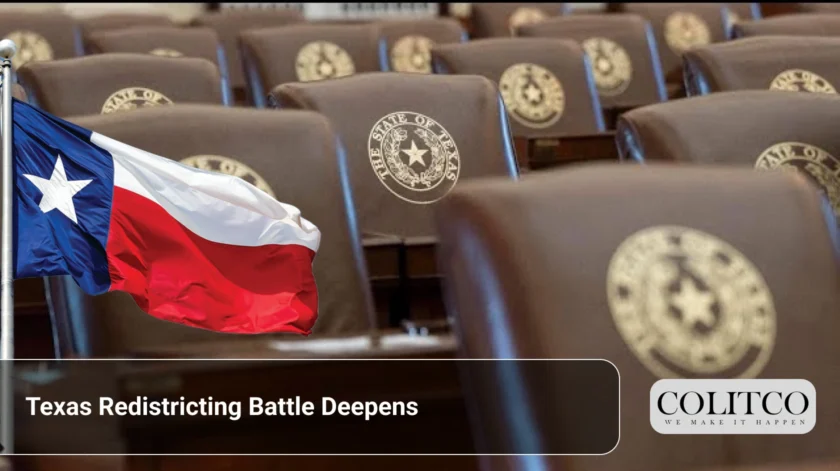Why is Texas redistricting driving national debate?
The Texas redistricting fight has now jumped beyond state politics into national politics. Congressional maps are at stake. While Republicans are moving forward with their attempt at Republican gerrymandering, which is criticised for leaning the scales in their favour, the Democrats decry it as an attack on voting rights and representation.
The Democrat walkout was staged in Texas to block a quorum and halt Republican plans. With no quorum, no legislative action could be taken. However, as soon as the Texas House restored quorum and session, Republicans started rushing ahead. This further fueled discussions on partisan-induced redistricting and its probable ramifications on elections of 2026 and beyond.

Texas redistricting fight turns national
How did the Democrats’ walkouts alter the political landscape?
Democratic lawmakers took the rare step of leaving Texas to prevent a quorum, seeking to put a stop to or at least delay redistricting bills adversely affecting minority rights.
This giant step has turned things national. Civil rights organisations rallied behind the Democrats and declared the walkout an effort to secure fair representation. Republicans called it political theatre meant to rally fundraising.
Once the Texas House quorum was restored, the session resumed, and Republicans advanced swiftly. However, the walkout achieved the goal of making the situation more visible to activists and presenting the issue as a general test of democracy.
What is California’s counterplan to Texas?
California Governor Gavin Newsom was instrumental in proposing what has come to be called the California Newsom counter plan, keeping in mind transparency and independent oversight. In California, the mapping process is carried out by a non-partisan commission to reduce partisan interference.
Newsom came to lay out another perspective by presenting a counterargument. By making the case against Texas, California was positioned as the reform alternative. Analysts say his bid seems to aim at shaping the national discourse and strengthening Democratic messaging.
The California Newsom counter plan may foster reforms in many other states trying to curb partisan dominance. The deeply entrenched divides between the two approaches in California and Texas are demonstrative of the fractured American democracy.

California Governor Gavin Newsom pushes counter redistricting plan
Republicans defend strategy while critics warn of damage
Republicans insist that their Republican-guided gerrymander has engagements with population shifts while keeping governance stable. On the other hand, critics say it locks in one-party dominance at the cost of electoral competition.
Civil rights leaders also warn of the damage of long-term minority representation. They argue that partisan redistricting saps away the confidence of the electorate in democratic institutions and fairness in elections.
The legal challenges will come. The courts will get to decide whether the Texas maps violate the Voting Rights Act. Any ruling from this will build precedents across the country, hence shaping redistricting battles in other contested states.
Democratic resistance sparks broader political momentum
By walking out in Texas, Democrats did not stop redistricting, but they reshaped the political narrative. By breaking the quorum, the Democrats showed how the legislative process could be wielded to influence politics at the national level.
The strategy seemed to energise progressive groups, helped fundraise, brought in endorsements from prominent personalities, and pressured the Biden administration to reconsider federal voting rights protections. Republicans claimed victory once the quorum was re-established, with Democrats stating that they intend to continue escalating their resistance. The episode showcased how state governance becomes fragile with deepening partisan polarisation.
Also Read: Texas Longhorns Claim First-Ever No. 1 Spot in AP Preseason Poll Ahead of High-Stakes Season Opener
What lies ahead in the redistricting wars?
The conflict in Texas is likely to go on for some time. Lawsuits may be filed after the new maps are finalised. Similar conflicts are also cropping up in Florida, Georgia, and North Carolina, highlighting a nationwide strife.
In California, the Newsom counterplan strengthens the case for independent commissions. Yet, Texas Republicans are committed to retaining their hold. With the quorum of the Texas House restored, the fight is now headed to the courts.
Analysis warns that partisan redistricting could harden divisions into the 2026 midterms. Should it succeed, GOP gerrymandering tactics may well steer the balance of power in Congress.
The Texas-Californian controversy is a metaphor reflecting the greater clash over American democracy. It encapsulates the state battles that ultimately determine national politics, transcending the boundaries of the local scene.












